I bought Kanban EV so long ago that I can’t even remember what made me aware of it in the first place. Maybe I saw it in the BGG top games ranking (currently at an impressive number 46) or in No Pun Included’s excellent review of it, I don’t know. What I do still remember is opening the package it came in and not only being blown away by what at the time felt like a humongously large box but also the impressive quality of the components inside it. Trays, screen printed tokens, dual layer boards, extra thick cardboard tiles, even a plastic lid inside the box to keep things neat when storying the game vertically. What by now are things that can be found in many games was back then very new to me as I hadn’t jumped into crowdfunding yet.
Kanban EV was also my very first game by designer Vital Lacerda. By now, I have owned (or played) most of his big box titles, but Kanban EV is one of only two that still remain in my collection … and definitely the one I return to the most. So it was long overdue to finally write about it …
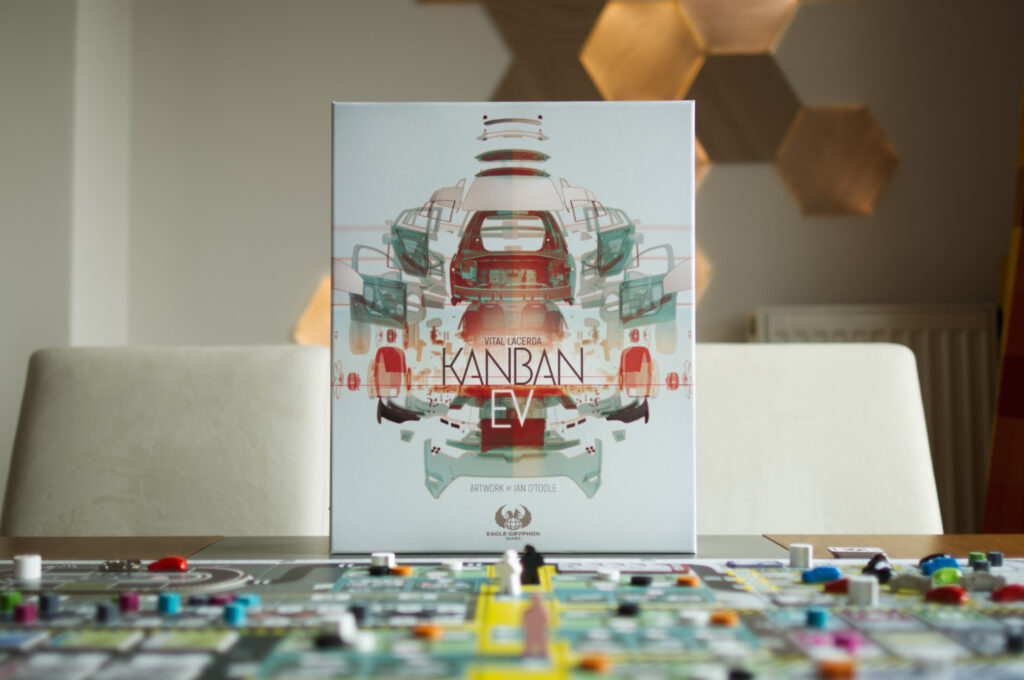
Setup
Considering the number of components to be found in the box, it’s not too surprising that setting up Kanban EV takes a bit. 6 different resources (9 when counting the larger white speech bubbles, books, and wild resource tokens), five types of cars, upgrade markers, certification track tokens, a large meeting marker, car design tiles, dual layer player boards, wooden padlocks, garage tokens, … this is one of those games that I won’t even attempt to play without getting the extension for my dining table out. There are so many elements in this game that I will have to gloss over lots of details during the discussion and just give merely a broad overview instead.
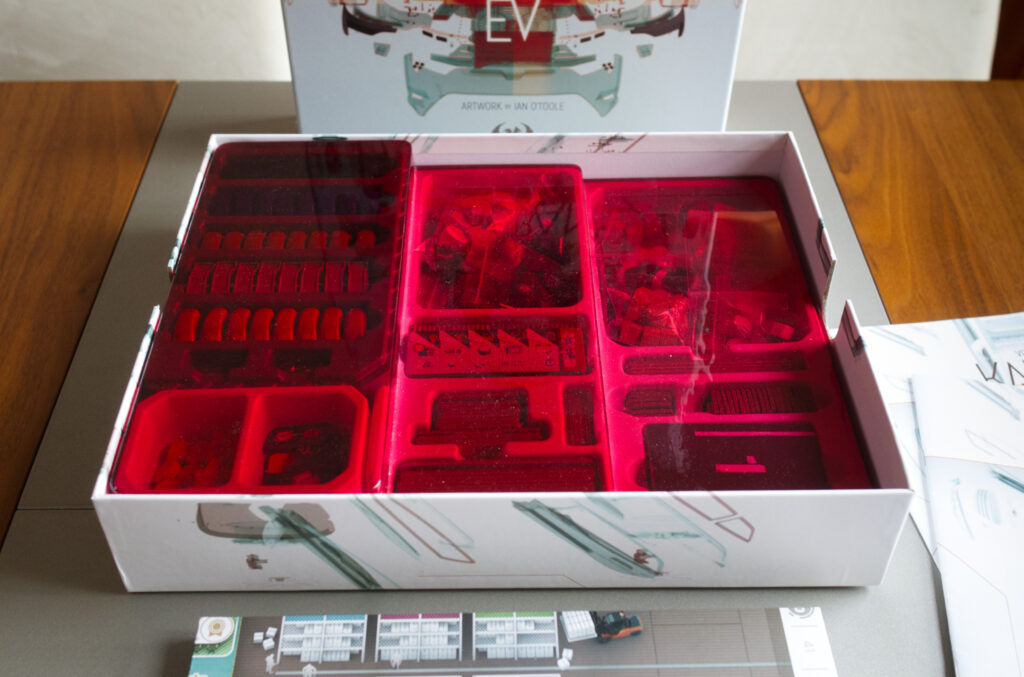
The players are workers inside the same car factory. The large main board is split into various departments—from R&D and Logistics to Assembly, Design, and Administration—with a connecting yellow walkway in the middle which contains the worker placement spots for all the departments. Each department occupies its own separate section on the board and requires its own little setup such as placing cars on predefined spot in the Assembly department or laying out design tiles in the Design department. Luckily, due to a well designed insert and trays, there at least isn’t any laborious sorting.
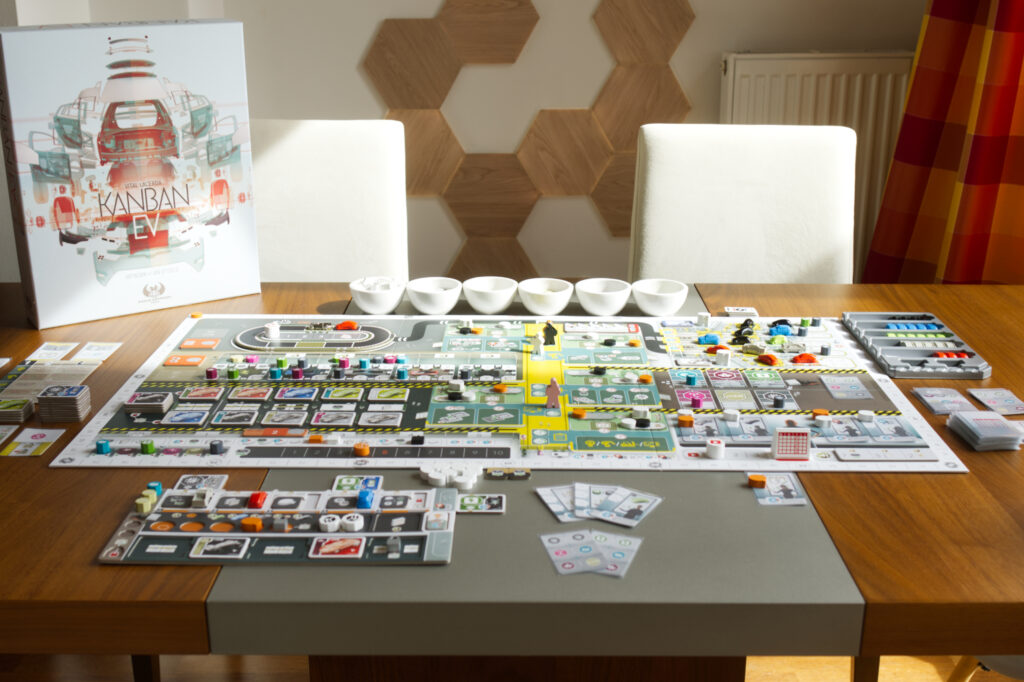
The Turn
In Kanban EV, players try to earn “Production Points” (=victory points) by producing in-demand cars, upgrading parts, or collecting any number of other small bonuses here and there. The main source of points though come from doing things one can brag about later during the next company meeting. How lovely!
Each round in Kanban EV works in two steps: first, all players in turn select the departments they want to work in that round and once this is done perform said work in the new order, from top to bottom following the various department action spots along that yellow strip on the main board. Designer Vital Lacerda is famous for creating some of the more complex games out there while at the same time joking it’s just “place your worker, do the thing”. While technically true, the decision where to go can be agonising up to the level of AP-inducing. So let me first explain the core loop of the game before going more in depth into what the various aspects of Kanban EV do to contribute to that complexity.
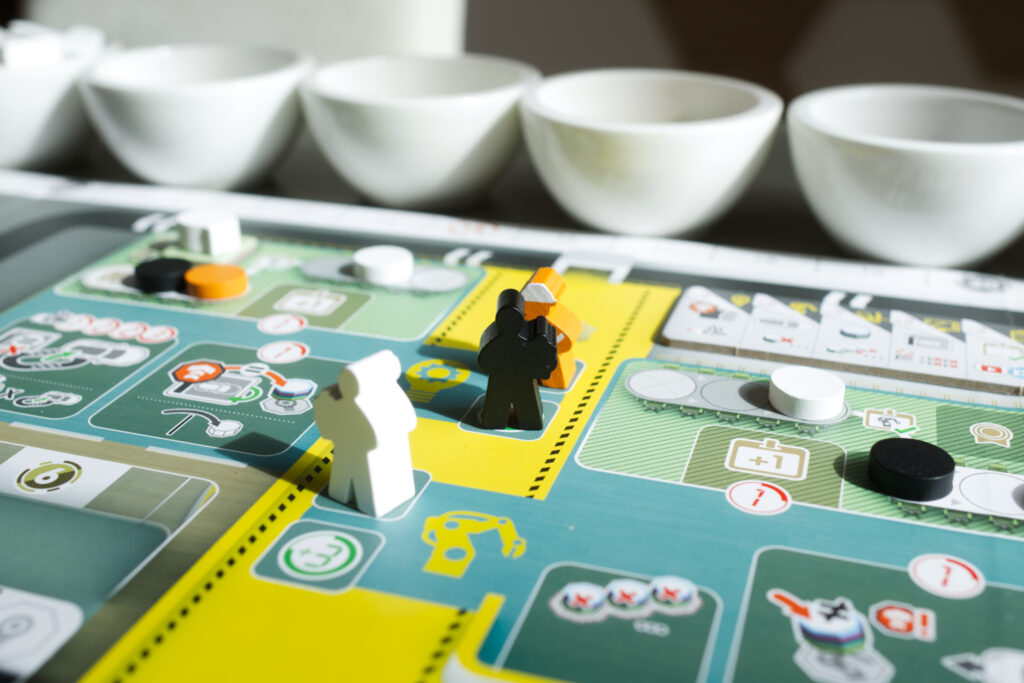
Each of the five departments in the game has two action spots, one with a higher and one with a lower amount of action points printed on them that the player will be able to spent in that department. In most places, that’s 2 and 3 action points, so going sooner in turn order (=picking the lower value field) means basically sacrificing a third of a turn for it. Then there are only 2 spots per department, meaning just two players going there will already lock everyone else out of that department for the whole round. And then there is the little problem of EVERYTHING being connected in this game. To be able to assemble cars, you first need to pick up the right resources from Logistics. To be able to acquire a car in R&D, you first need to go to Design, pick up a design tile of a matching colour, and for that car to be in R&D in the first place, someone will have had to assemble it.
So we are talking timing here: go to R&D too late and someone else might have snatched up that car you desperately needed, go there too early and that car might not have been produced yet. But we are also talking about efficiency. It doesn’t really make sense to go to Assembly to produce just a single car, especially if you can’t be sure you’ll be the one to acquire it later on. So maybe you should head to Logistics first, pick up more resources, and THEN go to Assembly. That surely would be more efficient … but who’s to tell what the other players will do in the meantime while you are wasting time trying to be more efficient? Whatever it will be, surely it will mess up all of your carefully crafted plans.
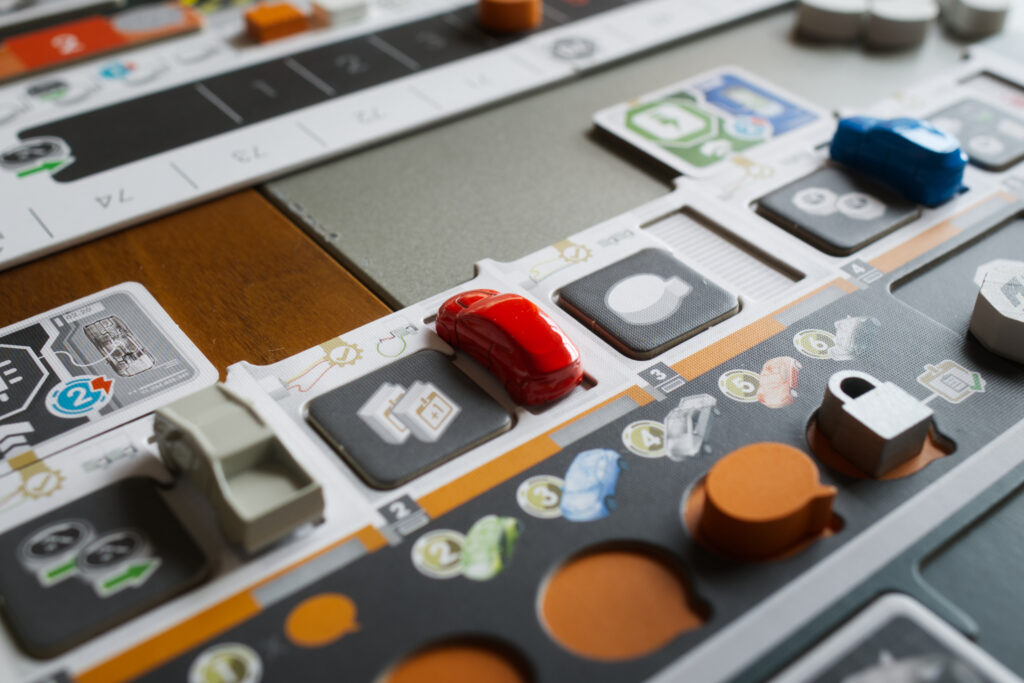
A Closer Look at Logistics
So let’s follow the life of a car. Logistics is where players pick up new resources representing various components needed for a car. For a single action point, a player can pick up all tokens of one type … or at least as much as they can fit into the limited number of storage spots on their player board. Spent another point and pick up everything of a second colour. As an alternative, players can also spent a point to put new resources on the board. This is done using some odd looking cards to limit players in what specifically they can generate. Each player has two cards on their hand and can place one of them in either of two printed-on-the-board positions. Then they go through every symbol on the card and figure out if the symbol on the card is on the same half above or below the thick middle line that is printed on the main board. If so, place the respective resource token, if not, don’t.
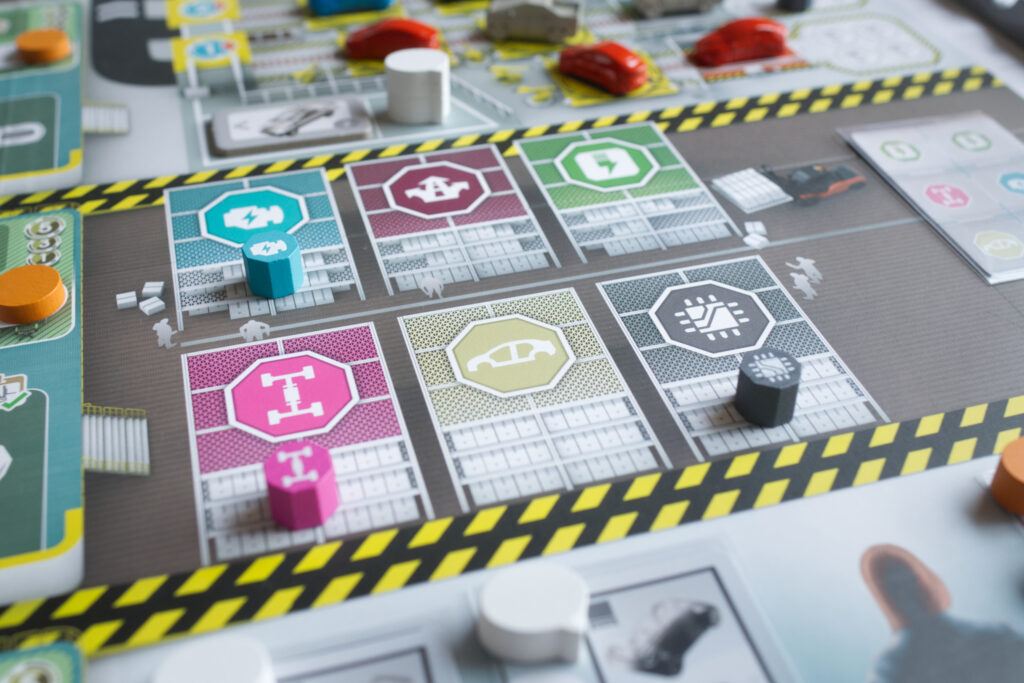
Generating new resources has the added bonus of given that player a “banked shift”, an action point to be spent in a later round. These are tracked on a separate track at the bottom of the main board. Note that a player cannot simply use less of the action points they received from the worker placement spot to bank them for later. No. Banked shifts have to be earned!
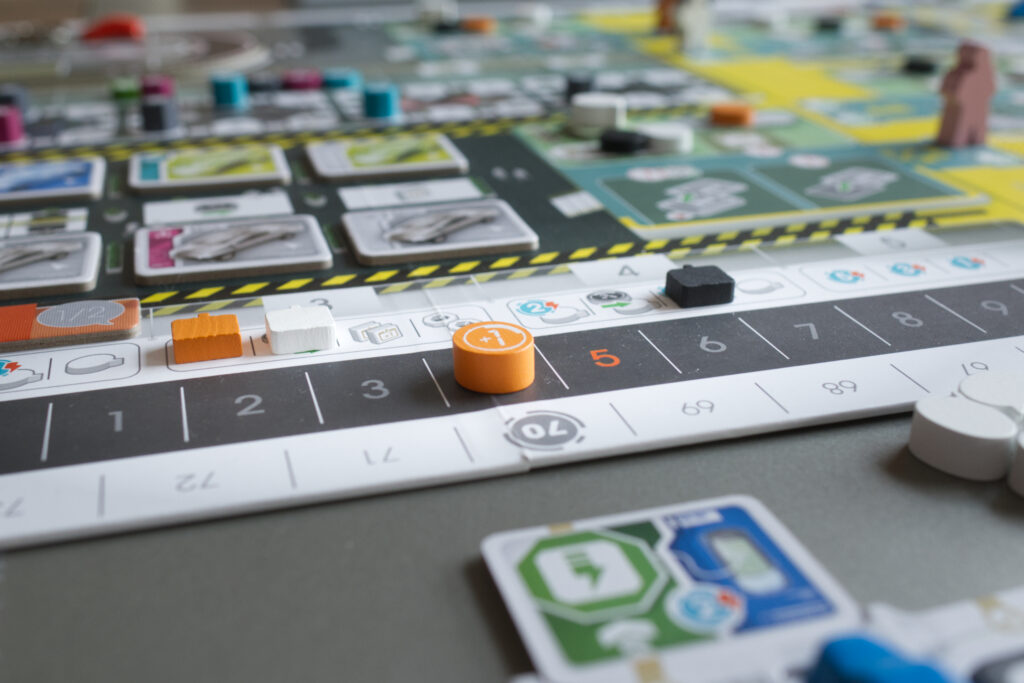
One thing that can be done in every department is to improve your training level for that department. Spent one action point and move your disc one step forward, it’s that simple. Go beyond the third step and you’re certified, unlocking some special ability on your player board and a new action in the department. For logistics, being certified allows turning an action point into a single wild resource called a “material voucher”. It also lets you progress on another track that will become relevant for meetings, but more on that later.
Reaching the last step of a training track not only means extra end game points but also picking up up a small one-time bonus cardboard tile and a speech bubble token … we’ll see those throughout the factory. In general though, lots of things done in Kanban EV will result in players having to chose between multiple options of small bonuses.
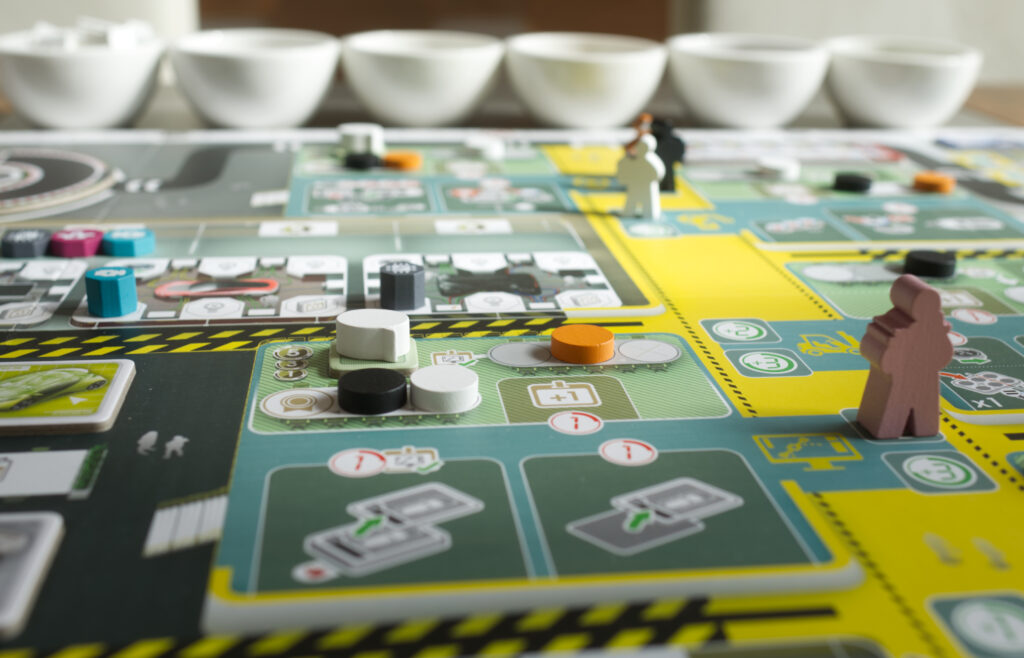
So going to Logistics is “simple”: pick the 2 or 3 spot for your worker, choose from the available actions in the department to spend them on, and end up with a mixture of increased training level in that department, new resources, new banked shifts, material vouchers, and potentially bonuses from reaching a certain training level. Well … not so simple after all, is it? While each individual piece is easy to understand, figuring out what exact mixture you will need 3-4 turns down the line will be tricky. Pick a red or a green resource? Spent more on training or rather have more resources? Invest that banked shift to do even more actions than you normally would? Time will tell what the right answer would have been …
The Rest of The Departments
Alright, let’s pick up the pace: in Design, players can spent action points to get new design tiles, cardboard tiles that show a) the colour of a car and b) potentially a part tile, which will become relevant later. Depending on the position of the design tile, players can earn additional banked shifts or “homework”, cute little book tokens that are basically a free action point that can only be used to improve one’s training. As with Logistics, we see the same training track and a special action that is only available for certified players.
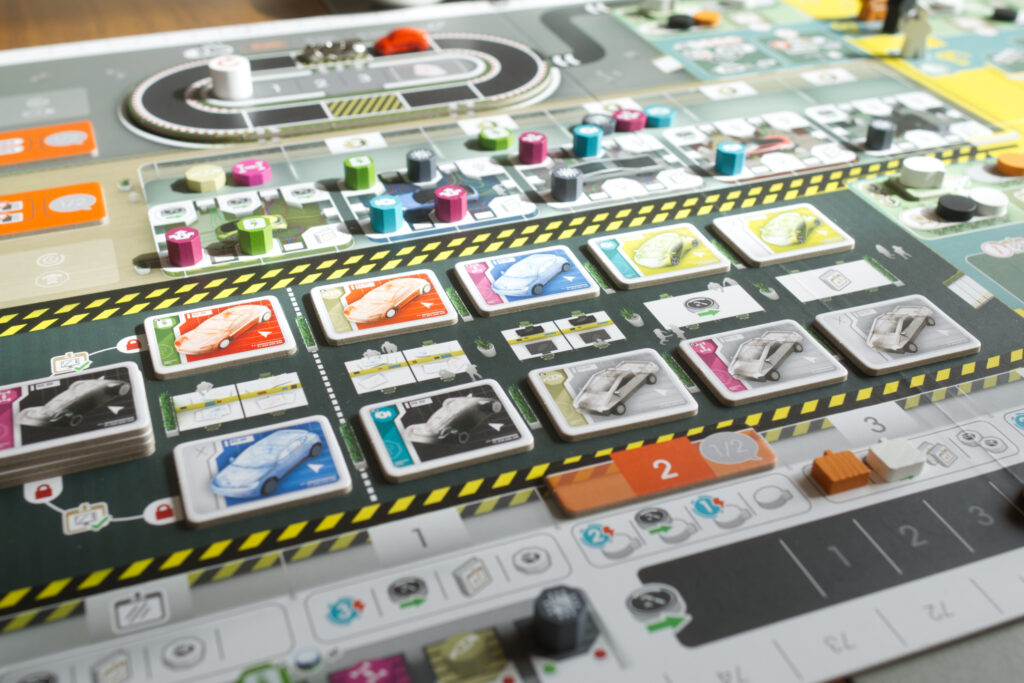
Note that similar to resource tokens, players can only pick up design tiles if they still have free slots for them on their player board. Initially there are four, with a fifth automatically being unlocked upon getting certified in the Design department.
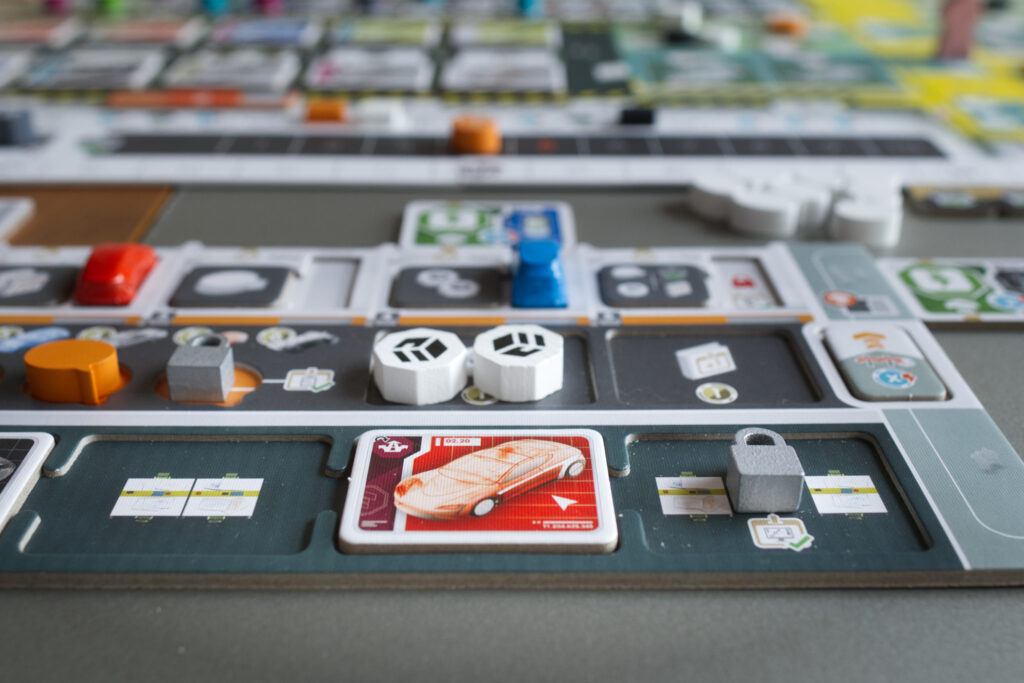
Assembly allows turning resource tokens into cars, featuring a little spatial mini game of which car to push out in what order, with speech bubbles to be earned when producing currently in-demand cars. Any car that is pushed out of Assembly is added behind the pace car on the R&D track (more on that in a minute). The main challenge here is to a) produce cars that are in demand and b) get the timing right so you yourself might have a chance to actually pick up the car before another player gets to it.
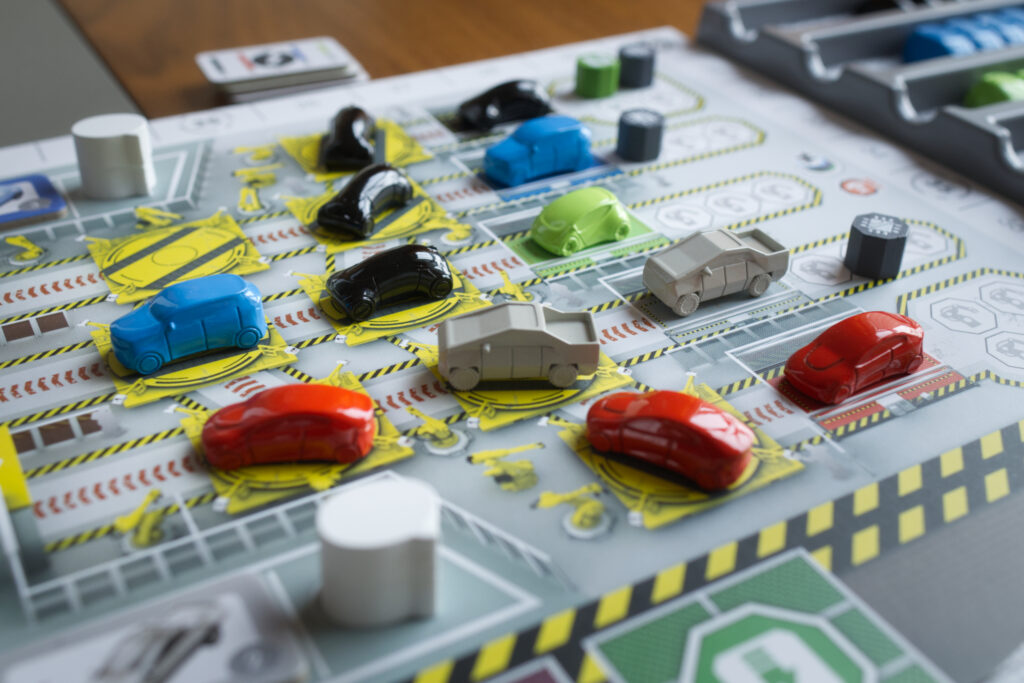
As the game progresses, another challenge is added though. Initially, to produce a car, a player just needs a resource token of a type that hasn’t already been used to produce that type of car (e.g. can’t use two green battery tokens to produce the two red cars, just one). As part of R&D though, players can turn design tiles and matching resource tokens into “upgraded designs” for some healthy bonuses and VP. The used resource tokens are placed in yet another section of the board that’s wedged between R&D and Design and from then on out, that type of car can no longer be produced with just any type of resource. Only upgraded parts can be used until all of those have already been used in that car type. E.g. if the green and black parts are “upgraded”, the first token in that car’s assembly slot has to be either green or black, the next the other colour, and only then the rest can be used. This doesn’t sound bad at first but you wouldn’t believe me how often someone wants to produce a certain car type and they just can’t get their hands on that upgraded part they need to do so.

The R&D department looks a bit strange because it is a small race track. New cars are added to the conga line following the silver pace car and as an action in this department, players can pick cars and put them in one of the garages on their player board. As you might have guessed, there is again a training track, gaining certification unlocks another slot for a new car on the player board, and there are some small immediate bonuses to be gained by getting a new car.
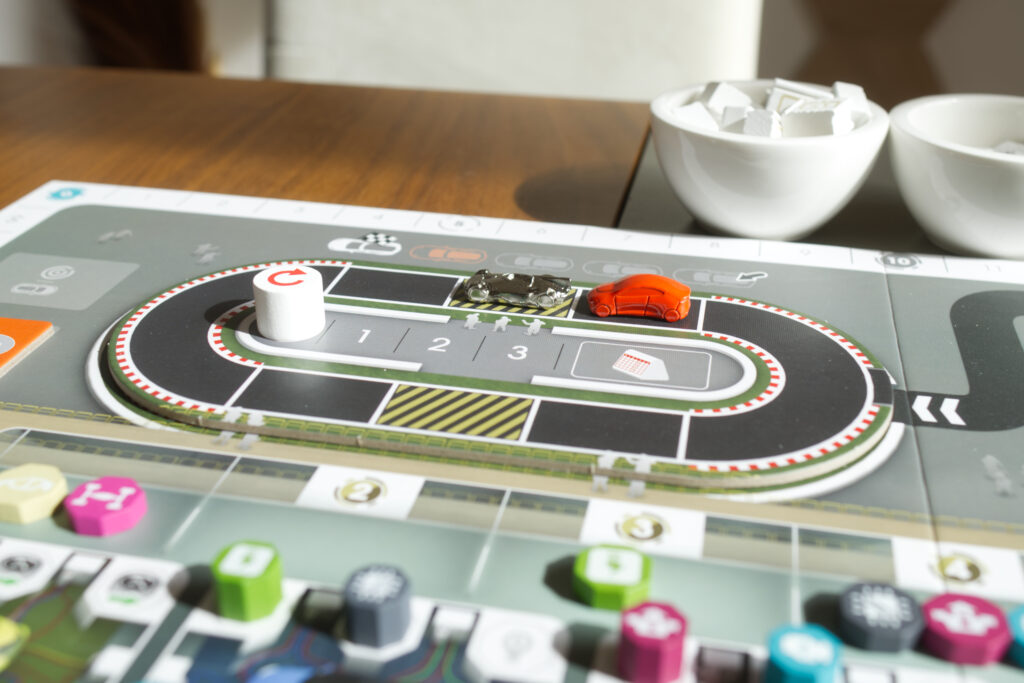
The final department is Administration, whose main function seems to be to allow a player to increase their training in any other department if all worker placement spots are occupied.
Introducing: Sandra, Your Boss!
Administration is also where Sandra initially starts. She’s represented as another meeple that also walks through the different worker placement spots. She not only blocks off one worker placement spot (making the game even more tight), but also will judge players if they have invested too little in their training. When it’s her turn to work, she checks which player has the lowest level of training in the department she is currently at and that player will have to pay VP unless they have fulfilled some criteria. E.g. if she checks the Design department, the lowest player gets penalised if they currently have two or less design tiles on their player board. For assembly, it’s car’s they have in their garage, for Assembly how many resources they currently own, etc.
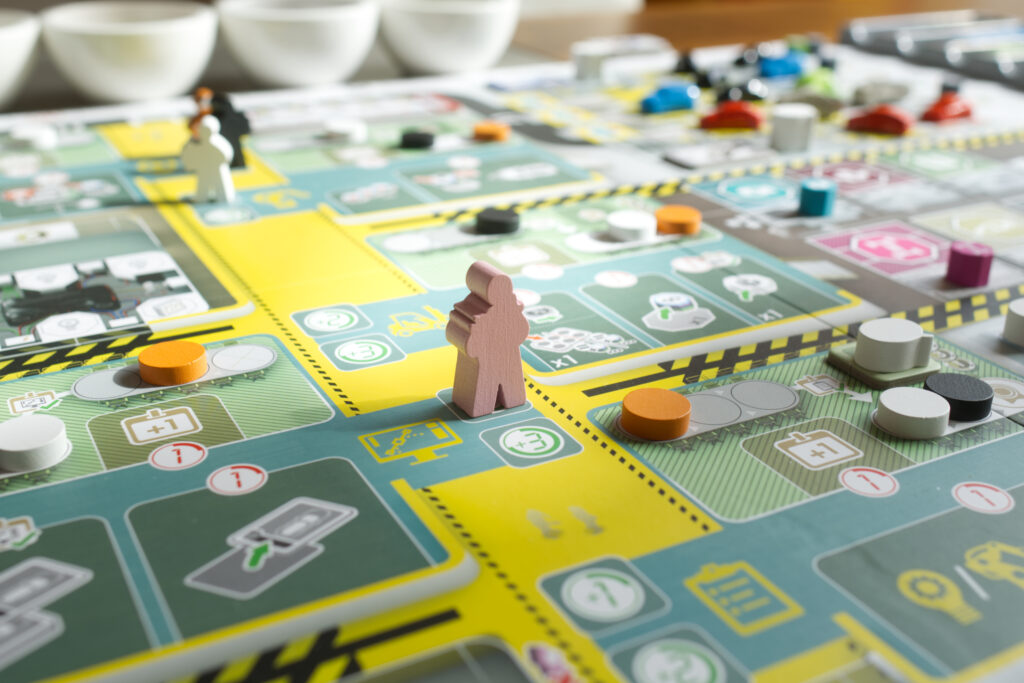
Sandra is not only annoying, she’s like the bane of your existence during the early game. Like a clockwork, she will step from department to department, from top to bottom, and you’ll know you’ll be in trouble if her next stop is a department you’re currently last on the training track. Then it will be decision time: do you ignore her and face losing VP because you don’t want to lose tempo? Delay what you had planned to do to quickly sneak in front of her and do some last minute training? Somehow raise the number of banked shifts you have (because that lowers the amount of VP you’ll have to pay)? Or gang up with another player to occupy both worker placement spots in that department so Sandra will skip that department completely? That might cause another player to be caught unaware that Sandra arrives early in their department! Choices over choices.
End of Week & Meetings
There are two main timers in Kanban EV: every time Sandra returns to administration, she’ll do a quick “end of week” evaluation and award players based on the cars they already have on their player boards. If on the other hand a certain number of cars have been picked up from R&D, the pace car moves over a marked spot which signals a meeting will be called.
For me, meetings are one of the most fun and thematic aspects of Kanban EV. Maybe I have worked in big corporations for too long, but I can totally relate to people crowding into a meeting room to show off how much value THEY bring to the company.
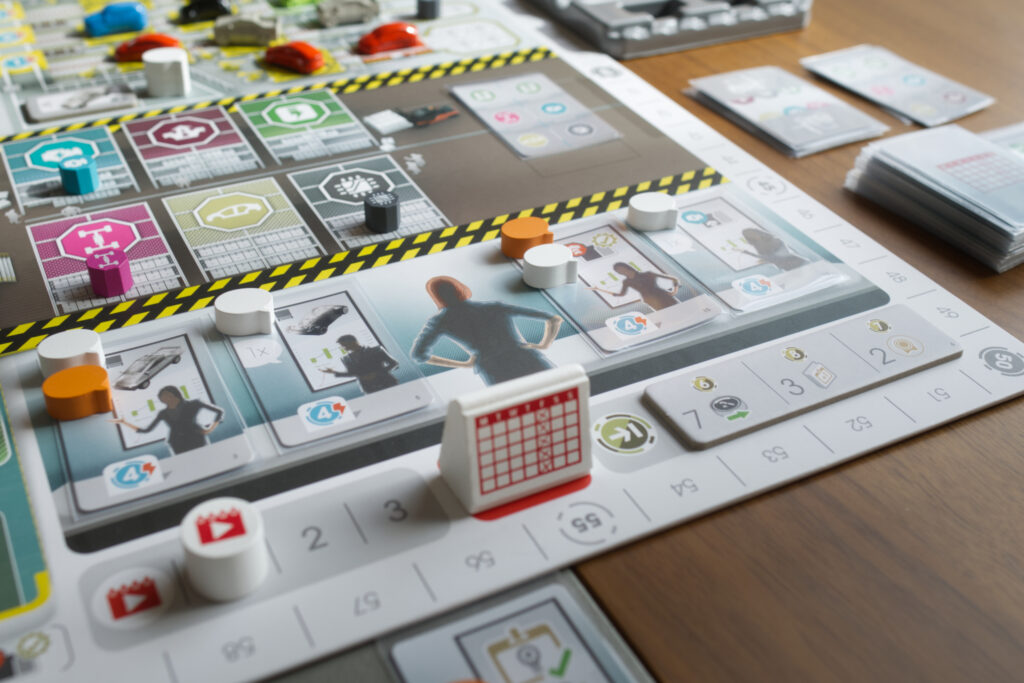
During setup, four “topics” are placed in the meeting section which are basically VP multiplier for certain criteria. E.g. get up to 2x 4VP for having grey cars in your garages. Or a certain number of upgraded part designs. In the order of the certification track (yet another section of the board that basically tracks who has reached certification status in the most departments), players can place speech bubbles they collected throughout the factory to convert them into VP. Sticking with the “grey cars” example, the card shows a base value of 4VP and a 1x and 2x spot. If a player places one of their speech bubble on the 2x spot, they get up to 2x 4VP, depending on the number of grey cars they actually own. It’s not unheard of that a dear colleagues who doesn’t own any grey cars at all will place their speech bubble on that very sport for no VP at all, simply to steel your thunder. Or for players to run out of speech bubbles quickly because they haven’t hit certain goals on the factory floor.
At the end of the meeting, all players secretly pitch in one topic for the next meeting based on a small selection of potential topics they have on their hand. This serves as a nice incentive for everyone to aim for particular aspects of the game during the time until the next meeting. One thing to keep in mind though is: the next meeting may come sooner than you think. It all depends on how many cars are pushed out of Assembly and how quickly they are picked up from R&D.
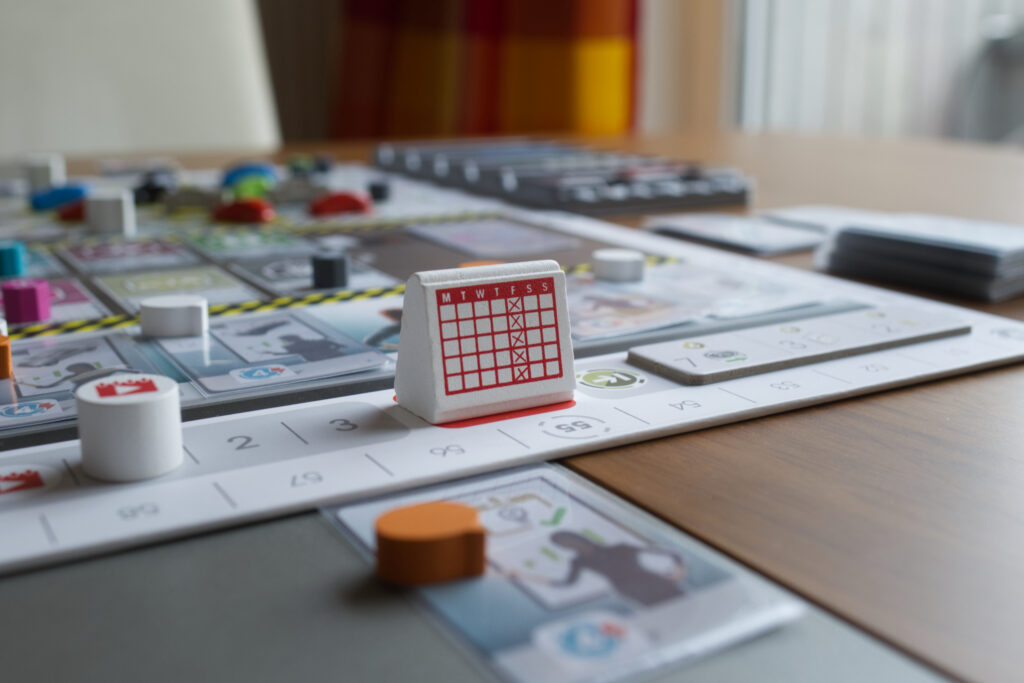
Game End
The game ends if there either have been 2 end of week scorings and 3 meetings – or – 3 end of week scorings and 2 meetings. Quite often, both will hit 3 in the same round, but not always.
During end game scoring, points are awarded based on the cars picked up (black cars are more valuable than green ones for example), tested designs (design tiles a player has used to upgrade a part but then also managed to pick up a car of the same colour), and a few other sources. If they are left with any more speech bubble tokens, they can convert up to three into additional end game scoring based on the scoring tile that is placed in the lower-right corner during setup.

Solo Mode & Player Count
I’m usually not the biggest fan of David Turzi’s style of automa, but man, this is a good one! You will compete against two colleagues that have one goal: trying to get you fired. For every VP they make, you lose one, and if you are at zero (or below) after a meeting, you instantly lose. How charming!

Mechanically, three options are available each round for which departments the colleagues might use. If it’s an automa’s turn to choose a department, flip a selector card from a smaller-sized deck of cards that indicates if the top or bottom most of the available options is used. This simulates that in a multiplayer session one usually has an idea of which departments might or might not make sense for another player to go to. Playing solo, it allows the human player to gamble a bit: if for example you know that no R&D department card is currently available, you can safely use the +3 spot instead of the +2 spot. If an R&D card is among the possible choices, you can figure out if you want to risk that the automa might end up ahead of you in turn order or not. Turzi has used a similar “limited choice” mechanism in other games, but I think this is where it works best.
To spice things up for repeated plays, a deck of trait cards has been added, something I always appreciate in a solo mode! Draw two during setup and they will give the two automa special abilities, such as starting already certified in all departments (=causing more powerful actions by that automa) or getting more VP for certain aspects. Using these cards makes the solo mode brutal! I’ve played Kanban EV dozens of times, and it still can happen that I get fired after the first meeting when using these! It’s such a great idea to add replayability and adjustable difficulty, I wish more games would use a similar mechanism.

As to general player count: I’ve mostly played this at two player but haven’t really noticed any concerning differences with more players (except for more people, more thinking time of course). It’s a meaty 2+ hours experience anyway, so I don’t mind the extra time if there are more players involved. Note: there are some small changes in 2p mode, the most important one being that human players are not allowed to step into the department Sandra is currently in.
The Supercharger Expansion
Publisher Eagle-Gryphon Games often uses the same model for their Lacerda Kickstarters: add a small expansion that backers get for free but that buyers of the retail copy will have to purchase separately. It’s a neat mechanism that doesn’t lock anyone out from getting the full gaming content but still reward backers.
For Kanban EV, this comes in the form of a new mechanism: Superchargers. I guess it’s already telling that despite having used them two or three times, I couldn’t tell you anything about them without having to re-read the rules. So I just did. Basically it gives you something to unlock when working in Administration. By spending an action, a super charger token can be placed on a small personal player board which lifts a restriction or enhances an existing action. There is a matching set of meeting cards (not shown in image) and end game scoring tiles.
The way I remember it, it was neat to play with them, but more to have something different, not because it adds anything especially important to the game. If you’re in the market for buying Kanban EV, I would say you are safe to skip on it.
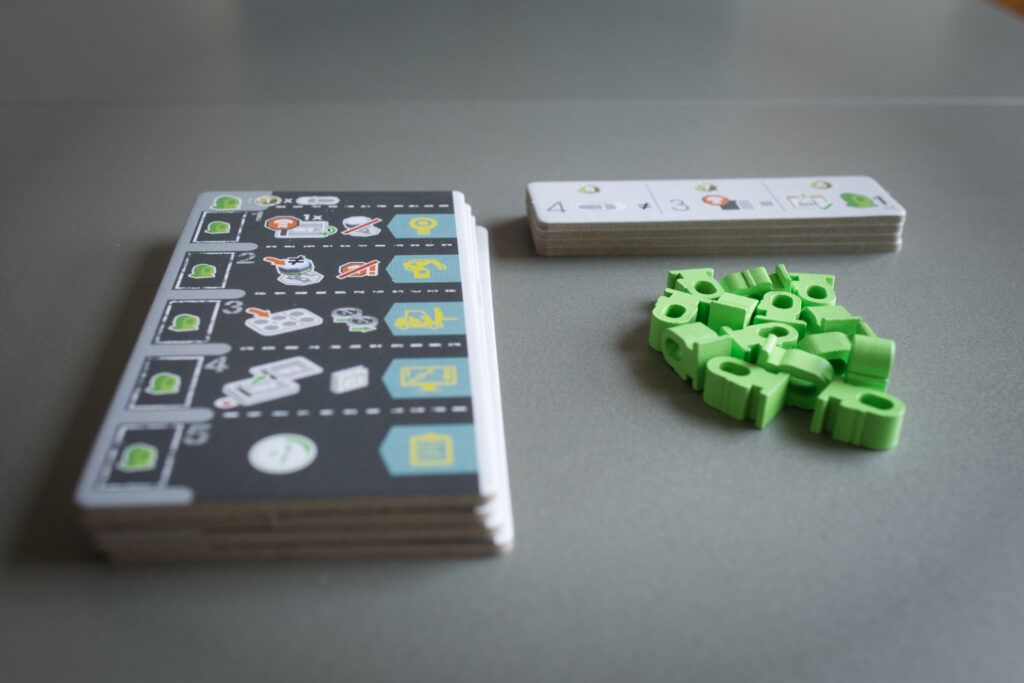
Metal Cars
Another optional add-on are metal replacements for the wooden cars. They come in a tray that is exactly the same as the one containing the wooden cars that come with the game, so they can easily be swapped. There is no further purpose to them other than looking pretty.
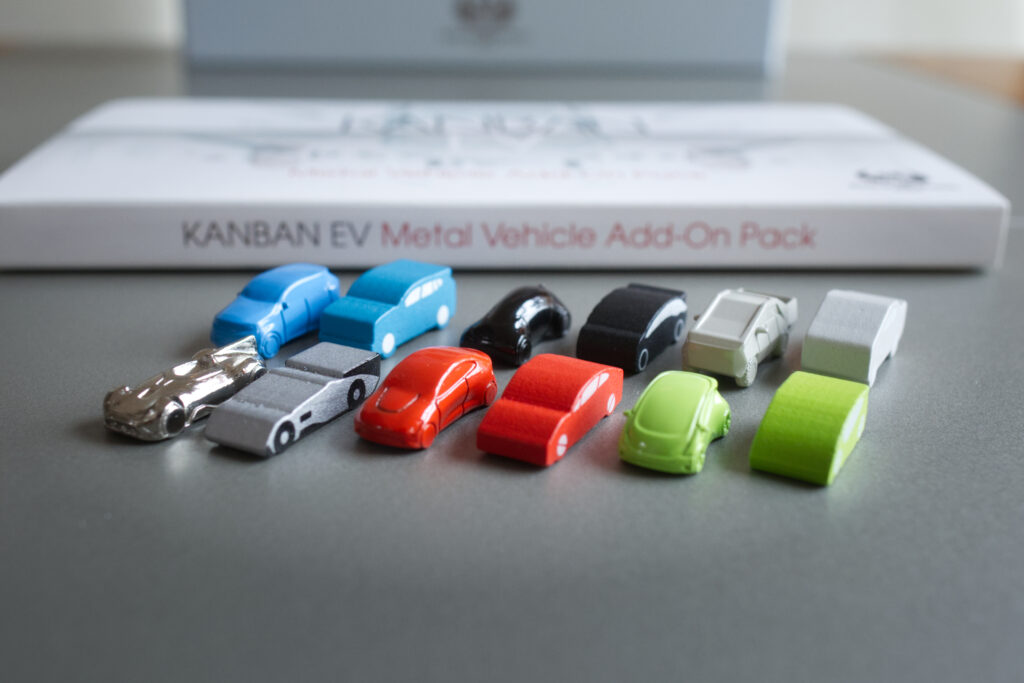
I only got them recently as a tag-on to another Kickstarter campaign, after many, many enjoyable plays. The wooden cars are totally fine and one could easily argue those provide a more consistent look with the reset of the game. But I was curious so I got the metal ones. You can make up your own mind if you “need” them or not.
Small side note: I have heard people had issues that the metal cars rubbed against each other in the box and arrived with their paint already chipped. If I remember correctly, mine came individually wrapped, which was a horrible amount of plastic waste but I guess did the job. I haven’t had any issues with mine yet after playing with them a couple of times and storing in the base game box.
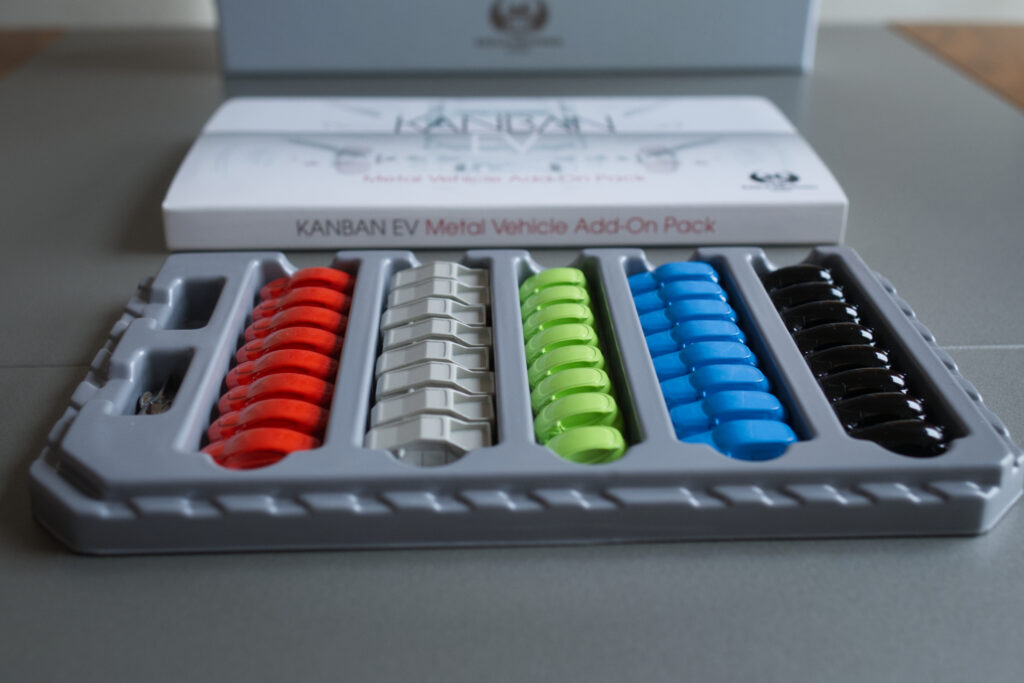
Conclusion
To be honest, I had a bit of a hard time writing about this one. It’s not to any fault of Kanban EV itself, but that it has been such a staple of my collection for years now. Usually when I play a new-to-me game, I quickly can come up with a writing hook or unique story to tell as new impressions are forming: what’s great? What’s not? What’s different to other games?
With Kanban EV, my brain immediately went to a big “what’s there to tell? It’s great!”. Kanban EV—for me personally—has completely lost this new and unexhausted sheen that games have when you play them the first few times and before re-playing it for this review, it has been half a year or more since I had played it the last time. The question I had to ask myself was: Is this really as great as you remember it or are those just the fond memories you had with it? So let me try to approach this review with a mix of the impression Kanban EV made on me when I was new to it and how I see it now.
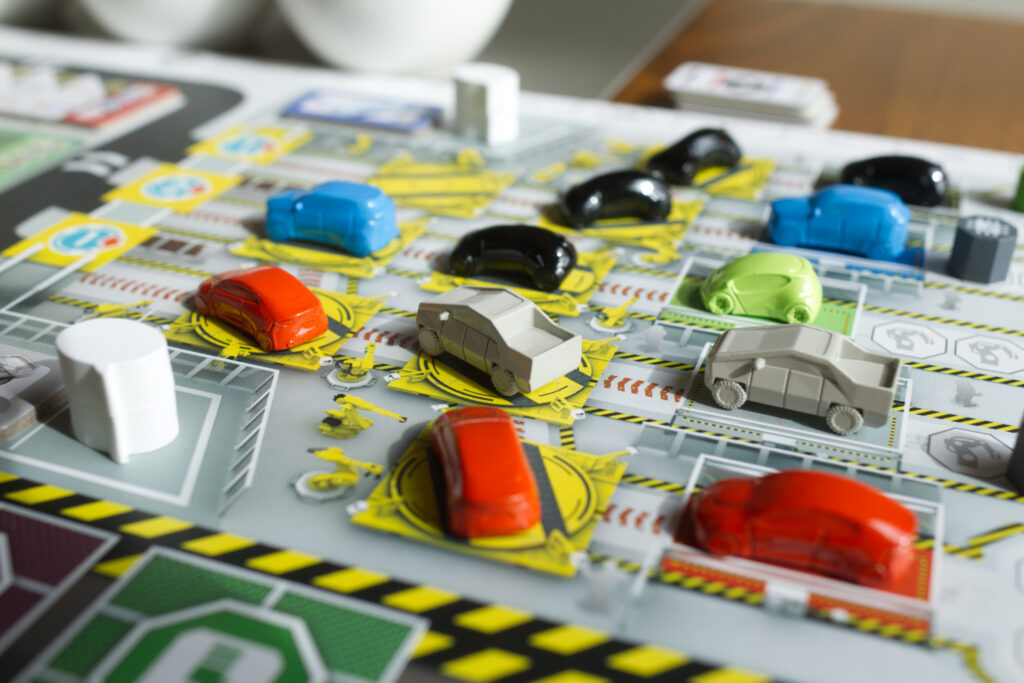
I still remember what a hard time I had to get into Kanban EV. I’m used to complex games, but somehow this one stumped me. It’s not that the individual actions are complicated, more that I just couldn’t wrap my head around how everything fit together. I had to read the rules, try it solo, watch some playthroughs, correct some errors I had made, try it again, watch another playthrough, … and then it suddenly clicked. Make no mistake: this is a heavy game, and it will take a bit to learn and internalise the 20+ pages of rules, especially if you have no one to teach the game to you.
I’ve before compared Vital Lacerda to a master clockmaker. He is unique in how he plays with mechanisms in a way that it is hard to remove any single one of them. Many other designers add side-mechanism upon side-mechanism to buff a simple core up into something complex. With Lacerda, it’s just one massive thing and I marvel how the whole thing can work at all … and as smoothly as it does! I usually approach heavy games with the same critical question of whether or not they really needed all those components and all those mechanisms. And unlike many other designers’ works, every time I poke and prod at one of Vital’s games, the answer is “damn, apparently yes”. In Kanban EV for example, one could ask if it really needed the whole concept of upgraded parts/designs. It looks like a throw-in bonus thing and then you play it and generate absurd amounts of points with it if done right, while at the same time giving your opponents a hard time to assemble new cars. Or the parts exchange area in the lower left corner where you can “trade” resource tokens. Seems like a superfluous thing but I couldn’t tell you how many games I’ve played where what was available in that section was crucial.
What makes Kanban EV stand out for me—even over other Lacerda designs—is how elegant it is, despite all its complexity in decisions. I’ve played it so many times by now that the rules almost completely fade away and it’s all about player interaction and reading the board state. That juicy decision where to go next, whether to pick the higher or lower spot in a department, what to focus on and what not. Kanban EV is one of those games where I only realise how complex it is when I have to teach it to new players or play it with people who haven’t played it in a long time. Sure, they can do the actions, but can they do them well and in the right order for what the board state suggests?
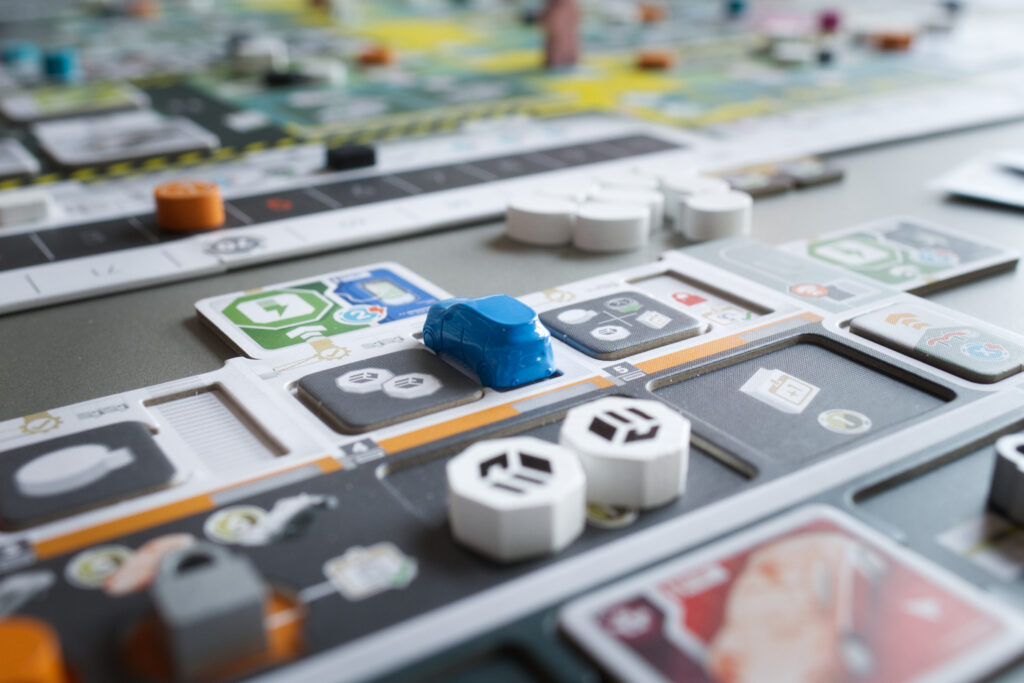
If you enjoy this kind of sequencing, this “do it now or take a small detour?” kind of thinking, Carnegie does it brilliantly and way more approachable. Mistakes and effects are more direct, easier to understand, easier to learn from. Kanban EV has the same feeling of skipping rope and figuring out the dance but combined with the tightness of an Evacuation! I’ve definitely lost games because I picked the wrong colour of resource when I did a Logistics action or ended up being in the wrong department at the wrong time although at the start of the turn it had looked like I would be exactly in the right place to be. That’s the juicy thing about Kanban EV: everything matters! You get a small bonus, let’s say because you upgraded a part, and a few turns later you curse yourself that you didn’t take that free homework token instead of a banked shift. It’s fascinating.
One thing where Kanban EV falls flat for me is the car factory theme. I think there are other Lacerda titles like Lisboa where the theme is much stronger. But Kanban EV redeems itself completely with its sleek Ian O’Toole look and that crazy meeting mechanism. That’s just funny to me! The solo mode with the two automa trying to get you fired is the cherry on top of it. Chef’s kiss. Mic drop. Brilliant.
To enjoy Kanban EV, you will need to enjoy a) actively throwing spanners into other people’s gears and b) these “should I do A before B” kind of dilemma. You also need to be willing to crunch through those rules and have a bumpy time before the game truly sings. Kanban EV is definitely not for everyone. Sandra is mean and punishing (yes, there is a positive variant, but I know no one that uses that), you constantly get locked out of things you want to do, mistakes snowball, it takes 2-3 hours to play, the solo can be brutal, it doesn’t have much in the way of instant gratification while you are playing it, it’s an expansive purchase … but if you want to dive into a) heavy gaming or b) Lacerda games, I think this is a timeless classic, a well rounded package that fires on all cylinders.
To sum it up: nowadays, few people talk about Kanban EV. The spotlight has long moved on to more recent releases. But it’s one of those few games that stand the test of time for me and is always worth returning to! It is a prime example of a great heavy game: Once you get the rules, it just flows. I also can’t remember ever having had a boring game of it. It’s agonising, but there is always SOMETHING that’s not going according to plan and might ruin you. A luxurious production and a highly re-playable, fun solo mode only add to great overall experience. If you don’t like agonising over tempo and sequencing, this won’t be for you. If you do, you should definitely give it a try!
